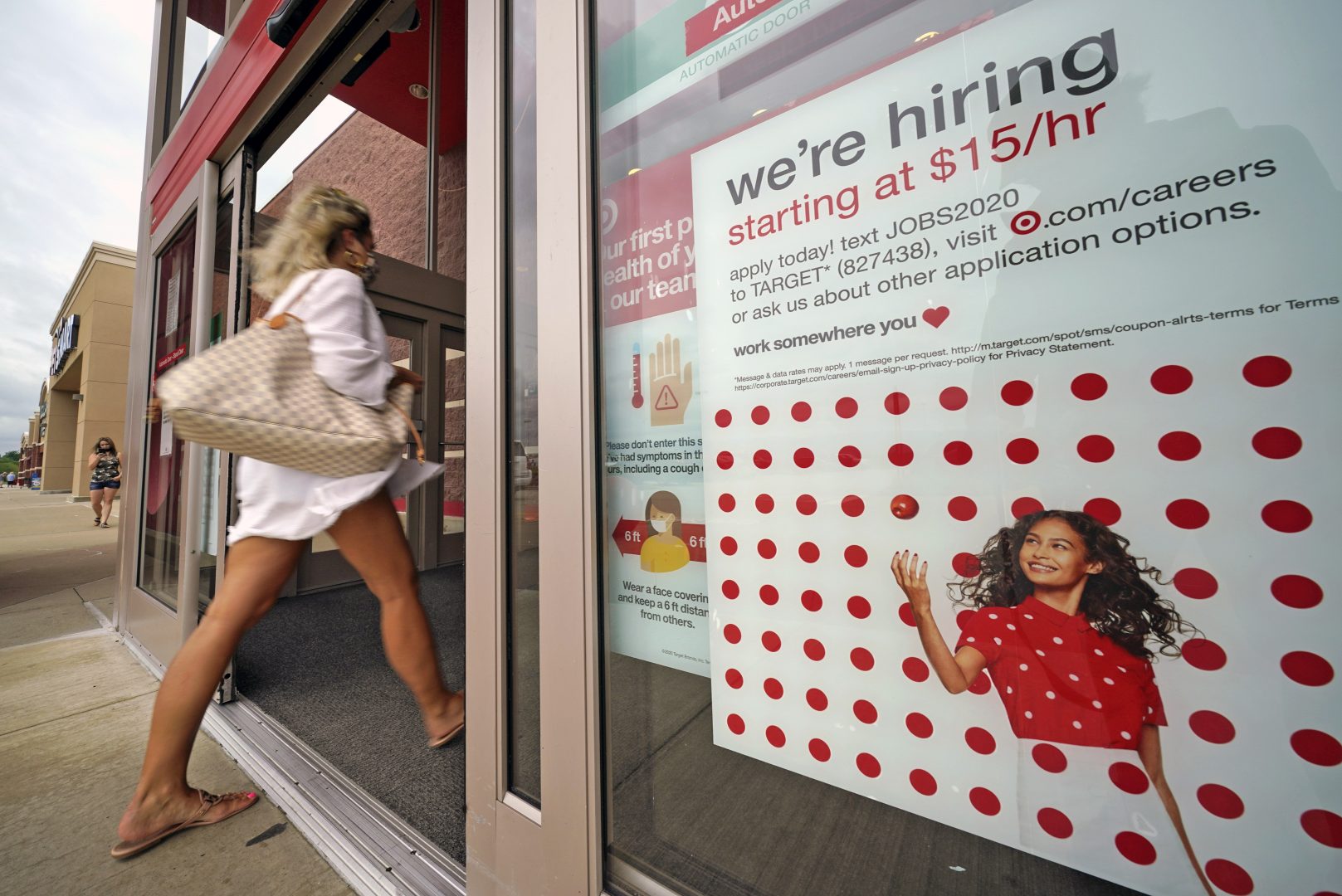
In this Sept. 2, 2020, file photo, a help wanted sign hangs on the door of a Target store in Uniontown, Pa.
Gene J. Puskar / AP Photo

In this Sept. 2, 2020, file photo, a help wanted sign hangs on the door of a Target store in Uniontown, Pa.
Gene J. Puskar / AP Photo

Gene J. Puskar / AP Photo
In this Sept. 2, 2020, file photo, a help wanted sign hangs on the door of a Target store in Uniontown, Pa.
Wages grew the most for Pennsylvania’s lowest-paid workers between 2019 and 2021, according to a study released Tuesday. But Harrisburg-based Keystone Research Center warns in its “The State of Working Pennsylvania 2022” report that rising earnings might not keep up with the pace of inflation.
Keystone, a progressive think tank that advocates for labor unions, found that, between 2019 and 2021, pay rose between 5% and 9% for workers whose earnings fall in the bottom third of the state’s wage distribution. All other workers experienced no more than 4% wage growth during the same period.
“It’s been a period of unusual, broad-based wage increases, the first such period in the last 40-plus years, except for the second half of the 1990s,” Keystone Executive Director Stephen Herzenberg said during a call with reporters Tuesday.
While he attributed the change to the still-hot labor market, in the new study, he and his colleagues note that average pay increases nationally have not kept up with rising prices. Between July 2021 and July 2022, the average U.S. worker’s wages jumped by 5.2% while inflation surged to 8.5%.
The researchers argue that labor unions represent workers’ best bet for maximizing their gains from the tight job market.
“Union growth not only changes the balance of power in the labor market and can lead to higher wages and benefits for middle and low-wage workers. [But it also changes] the balance of power in public policy,” he said.
For example, he said, the prospects of raising the minimum wage could improve thanks to the rising popularity of organized labor. On Tuesday, Gallup reported that 7 in every 10 Americans now approve of unions — the highest rating since 1965.
But despite notable union wins for University of Pittsburgh faculty members, Starbucks baristas and Amazon employees, Keystone acknowledged in its report that union membership has declined for decades. In Pennsylvania, it has flatlined since 2012 at roughly 14% of employed workers.
Employers, meanwhile, have struggled to hire since the economy came roaring back last summer from the pandemic-induced downturn. Federal data shows that in August 2021, the number of unfilled jobs in Pennsylvania exceeded the number of unemployed people for the first time in two decades. By June 2022, there were only about six unemployed workers in the state for every 10 reported openings, according to the data.
Statewide employment, in turn, has dropped by 116,000 non-farm jobs in the two years since COVID-19 brought much of the economy to a halt, Keystone estimated. In the Pittsburgh region, total employment fell by about 4% between January 2020 and June 2022, according to a new analysis by the University of Pittsburgh’s Center for Social and Urban Research.
Nationally, the ongoing mismatch between labor supply and consumer demand has contributed to soaring inflation. But while the Federal Reserve has raised interest rates in an attempt to stabilize prices, Keystone cautioned that higher borrowing costs could erode the real value of workers’ wages.
In its research released Tuesday, the think tank highlighted widening pay disparities along racial and gender lines. Last year, median wages for Black and Hispanic workers amounted to roughly 75 cents for every dollar earned by white workers, Keystone reported. It said, in 1980, Black workers typically made 90% of wages paid to their white peers.
Today, the typical woman in Pennsylvania earns 80 cents for every dollar her male counterpart is paid, the study said — an increase from the roughly 60 cents they made on the dollar in 1979.
Keystone urged lawmakers to raise the state’s minimum wage while also establishing additional wage and benefits standards for specific sectors such as trucking, caregiving, manufacturing, health care, and higher education.
Since 2009, the minimum wage in Pennsylvania has stood at $7.25 per hour, the same as the federal floor but lower than neighboring states. Democratic Gov. Tom Wolf and his allies in the legislature have failed to convince the GOP-held body to raise the rate.
Keystone estimates that the $7.25 hourly wage has 27% less buying power than in 2009 and that the minimum wage is at its lowest inflation-adjusted value since 1956.
The study said the state should raise its rate to “a living wage.” It cited data from the Massachusetts Institute of Technology that suggests the figure would equal $16.67 per hour. The MIT research defines a living wage as one that covers basic needs, not including entertainment, prepared foods from a grocery store or restaurant, vacation, or savings.
Keystone also called on state leaders to develop more muscular infrastructure for job training. The state has invested in training and apprenticeship programs since the early 2000s, but Keystone called for more “co-investment” by both the private and public sectors. It suggested a =tax credit that would refund companies for half of their investment in qualifying training and education.
“It’s time to stop playing at the margins and to use a creative approach to shared investment in work-relevant skills by businesses and government,” the report said.

Get insights into WITF’s newsroom and an invitation to join in the pursuit of trustworthy journalism.
The days of journalism’s one-way street of simply producing stories for the public have long been over. Now, it’s time to find better ways to interact with you and ensure we meet your high standards of what a credible media organization should be.